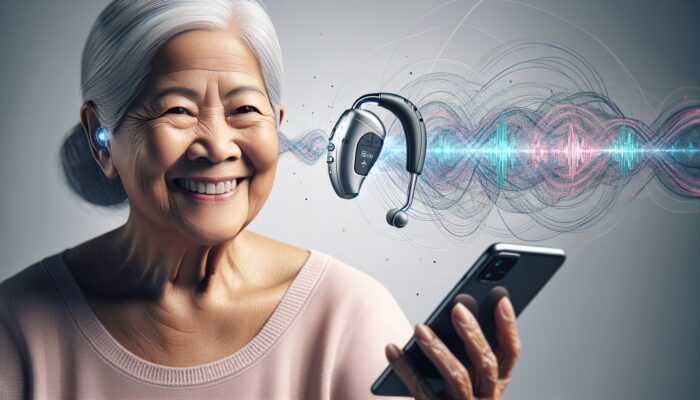Last Updated on 10/10/2025 by Admin
Comprehensive Guide to Hearing Loss Management
What Exactly Is Hearing Loss?
Hearing loss refers to the partial or complete inability to hear sounds, affecting individuals of all ages and backgrounds across the globe. This condition can be caused by a variety of factors, including genetic predispositions, the natural aging process, and particularly, exposure to loud noises. The intricacies of hearing loss are profound, as it presents in various degrees, each of which can significantly affect an individual’s ability to communicate and interact socially. If left unmanaged, these challenges can lead to feelings of isolation and frustration, as individuals may struggle to fully participate in conversations.
Furthermore, the experience of hearing loss can vary widely among individuals, influenced by unique personal circumstances and environmental conditions. Recognizing these discrepancies is essential to creating effective management strategies. For example, some individuals may only face challenges in particular environments, such as crowded restaurants or busy streets, while others may experience difficulties even in quieter settings. By understanding the diverse nature of hearing loss, we can implement personalized strategies that significantly enhance the quality of life for those affected.
What Are the Different Types of Hearing Loss?
There are three primary categories of hearing loss: conductive, sensorineural, and mixed types. Each category has distinct underlying causes and requires tailored management strategies. Conductive hearing loss arises when sound transmission is blocked in the outer or middle ear, often due to issues like ear infections or fluid accumulation. This type of hearing loss is frequently treatable through medical procedures or surgical interventions.
On the other hand, sensorineural hearing loss is the most common form, typically resulting from damage to the inner ear or the auditory nerve. This damage can be attributed to factors such as aging, prolonged exposure to loud noises, or genetic factors. Generally, this type of hearing loss is managed with the aid of hearing devices or other assistive technologies, as it is often irreversible. Lastly, mixed hearing loss encompasses elements of both conductive and sensorineural loss, thus necessitating a comprehensive management strategy that addresses both components. Understanding these categories enables individuals to pursue proper evaluations and treatments tailored to their unique needs.
What Are the Main Causes of Hearing Loss?
The causes of hearing loss are diverse and can be influenced by both environmental and biological factors. One significant contributor is exposure to loud noise, particularly in environments such as concerts, construction sites, or bustling urban areas where noise pollution is prevalent. Over time, this exposure can cause irreversible damage to the hair cells in the cochlea, leading to permanent hearing impairment.
Aging is another prevalent cause, specifically characterized by presbycusis, which refers to the gradual decline in hearing ability associated with aging. Many individuals experience this type of hearing loss as they grow older, impacting their ability to engage in effective communication within social contexts. Genetic factors also play a crucial role; those with a family history of hearing loss are at an increased risk. Additionally, specific medical conditions, such as otosclerosis or Meniere’s disease, can complicate hearing health further. By identifying these common causes, individuals can take preemptive measures towards prevention and effective management.
Effective Strategies for Managing Hearing Loss
How to Utilize Hearing Aids for Better Hearing?
<a href="https://www.earwaxremoval.net/hearing-aids-regular-checkups-for-optimal-performance/">Hearing aids</a> are crucial devices designed to amplify sound for individuals experiencing hearing loss. Over the years, these devices have advanced significantly, allowing for customization to meet the specific auditory needs of users, making them an essential tool for enhancing communication, particularly in noisy environments. Modern hearing aids are equipped with cutting-edge technology that enables users to adjust settings based on their surroundings, greatly enhancing their quality of life.
- Enhanced sound amplification capabilities
- Settings that can be customized for various environments
- Improved speech recognition in noisy settings
- Bluetooth capability for direct audio streaming from devices
- Longer battery life with rechargeable options
- Discreet designs that accommodate different lifestyles
- Connectivity with smartphone applications for real-time adjustments
For individuals managing hearing loss, integrating hearing aids into daily routines can be transformative. These devices facilitate clearer communication and boost confidence in social situations. It is critical to collaborate closely with audiologists to ensure proper fitting and adjustments, which are essential for maximizing the benefits of these devices.
What Communication Techniques Can Enhance Understanding?
Effective communication is invaluable for individuals with hearing loss, especially in noisy environments. Several strategies can enhance understanding and enable meaningful conversations. For instance, lip reading allows individuals to visually interpret speech, making it easier to follow dialogues, even when auditory input is compromised. Pairing lip reading with careful observation of body language and facial expressions can significantly improve comprehension.
Utilizing visual cues is another effective strategy; ensuring good lighting can help individuals see the speaker’s face more clearly, while gestures can provide additional context. Speaking clearly and maintaining a moderate pace is essential; individuals should avoid raising their voices excessively, as this can distort sounds and complicate comprehension further. By mastering these techniques, people with hearing loss can navigate noisy environments more effectively, ultimately enriching their social interactions and overall experiences.
How to Modify Environments for Better Hearing?
Making environmental modifications can greatly reduce noise levels and improve hearing for individuals experiencing hearing loss. Adapting surroundings is often a practical approach to managing challenging listening situations. For example, selecting quieter locations away from heavy foot traffic or loud machinery can create a more conducive atmosphere for conversation. This may involve opting for smaller cafes instead of bustling restaurants, where background noise can be overwhelming.
Moreover, employing sound-absorbing materials, such as carpets, curtains, and acoustic panels, can help minimize ambient noise. These adjustments can foster a more peaceful setting, making it easier for individuals with hearing loss to engage in conversations. Implementing technological solutions, like sound masking systems, can further enhance clarity in communication. Transforming environments into more hearing-friendly spaces allows individuals to have better interactions and reduces the stress associated with noisy situations.
What Are Assistive Listening Devices and Their Benefits?
Assistive listening devices (ALDs) are invaluable tools that enhance sound quality directly to the ear, improving clarity in specific situations such as theaters, classrooms, or meetings. These devices are crafted to address the unique challenges faced by individuals with hearing loss in noisy settings. Examples include FM systems that transmit sound over radio waves, infrared systems that utilize light waves for communication, and loop systems that create electromagnetic fields around a designated area, allowing users to connect directly with their hearing aids.
The use of ALDs can significantly enhance the ability to hear and comprehend speech in noisy environments, often alleviating the strain associated with deciphering conversations amidst background noise. For example, in a crowded lecture hall, a student can benefit from a personal FM system that captures the instructor’s voice clearly, minimizing distractions. By incorporating these devices into daily life, individuals can greatly improve their listening experiences and elevate their quality of life.
Why Is Support and Counseling Vital for Individuals with Hearing Loss?
Hearing loss can have a profound impact on mental health, making it essential to have a robust support system. Engaging in support groups or counseling can provide emotional assistance, enabling individuals to share their experiences and coping strategies with others facing similar challenges. These resources foster a sense of community, helping individuals feel less isolated in their struggles.
Counselors and therapists who specialize in hearing loss can offer valuable coping strategies to manage the emotional and psychological impacts of this condition. Through tailored sessions, individuals can learn techniques to alleviate feelings of frustration or anxiety that often accompany communication difficulties. Additionally, participating in workshops focused on hearing loss can equip individuals with practical skills and knowledge that enhance their ability to navigate the complexities of daily life. Seeking support and counseling can help individuals cultivate resilience and improve their overall well-being.
Expert Insights on Navigating Hearing Loss in Noisy Environments
What Are Real-World Examples of Successful Management?
Real-world examples serve as inspiring illustrations of how individuals have successfully managed their hearing loss in noisy environments, demonstrating practical strategies that can be universally applied. One notable case involves Helen, a retired teacher who struggled to participate in conversations during family gatherings. By utilizing advanced hearing aids with noise reduction features, she was able to enjoy interactions without feeling overwhelmed by background chatter. This transformation allowed her to reconnect with her loved ones and engage fully in family events.
- David managed his hearing loss by employing a combination of assistive listening devices and strategic seating arrangements during meetings.
- Amy learned to utilize visual cues and lip reading, which greatly assisted her in navigating conversations within her bustling workplace.
- Mark transformed his home office by incorporating sound-absorbing materials, significantly enhancing his ability to communicate with clients over video calls.
- Linda joined a local support group, which provided her with essential coping strategies and emotional support in managing her hearing difficulties.
These examples emphasize that with the right tools and strategies, individuals can effectively manage their hearing loss in various noisy settings. Sharing such experiences allows others to gain insights into potential solutions that may resonate with their own challenges.
What Are Actionable Steps for Daily Life Management?
Experts recommend several actionable steps that individuals can incorporate into their daily routines to effectively manage hearing loss in noisy environments. Firstly, leveraging technology is crucial; investing in high-quality hearing aids or assistive listening devices can significantly enhance the auditory experience. Regularly checking and maintaining these devices ensures optimal performance, allowing individuals to maximize their benefits.
Secondly, employing communication strategies, such as encouraging speakers to face the listener or minimizing distractions during conversations, can greatly enhance understanding. Opting for quieter environments when planning social outings is another proactive step that can reduce auditory challenges. Additionally, engaging in regular hearing health check-ups is essential, as early interventions can lead to better outcomes in managing hearing loss. By adopting these strategies, individuals can actively participate in conversations and social interactions, leading to a more enriching life.
What Expert Analysis Reveals About Technological Advances?
The landscape of technology in managing hearing loss has undergone dramatic changes, particularly regarding hearing aids and assistive devices. Recent advancements have introduced features designed to enhance hearing in noisy environments, such as improved noise reduction algorithms, directional microphones, and Bluetooth connectivity. These innovations enable users to connect their hearing aids to smartphones or other devices, allowing for seamless audio streaming and customization of sound settings.
Moreover, the integration of artificial intelligence in hearing aids allows for adaptive learning, enabling devices to adjust functionalities based on user preferences and environmental factors. This intelligence dramatically enhances speech clarity in challenging listening situations, making conversations more accessible. As technology continues to advance, individuals with hearing loss can anticipate even more refined solutions that cater specifically to their needs, empowering them to navigate noisy environments with confidence.
How Does Noise Impact Hearing Loss?
What Is the Relationship Between Noise and Hearing Health?
Exposure to loud noise can result in both temporary and permanent hearing loss. Understanding the impact of noise on hearing is vital for developing effective management strategies. Short-term exposure to excessive noise may lead to temporary threshold shifts, where individuals experience a temporary reduction in hearing ability. However, prolonged exposure can cause irreversible damage to the delicate structures within the ear, ultimately resulting in permanent hearing loss.
Research indicates that environments characterized by consistent loud sounds, such as concerts or industrial workplaces, pose substantial risks to hearing health. Therefore, recognizing the auditory dangers present in everyday environments is essential for prevention. Individuals must take proactive measures to protect their hearing in such settings, such as wearing earplugs or utilizing noise-canceling headphones to effectively mitigate risks. Awareness of these impacts is the first step toward developing a comprehensive strategy for managing hearing loss.
How Can Noise-Induced Hearing Loss Be Prevented?
Preventing noise-induced hearing loss requires a multifaceted approach that primarily focuses on reducing exposure to loud sounds. One effective strategy includes using ear protection, such as custom-fitted earplugs or noise-canceling headphones, particularly in situations where sound levels exceed safe limits. Limiting time spent in noisy environments, such as clubs or concerts, can also significantly reduce the risk of hearing damage.
Additionally, individuals should remain aware of their surroundings and seek quieter alternatives whenever feasible. For example, opting for outdoor activities in serene locations instead of crowded urban centers can create a more calming auditory experience. By adopting these preventative measures, individuals can protect their hearing health and ensure a more enjoyable auditory experience throughout their lives.
What Are the Long-Term Effects of Noise Exposure on Hearing?
Long-term exposure to noise can result in permanent hearing loss alongside other health issues, including heightened stress levels and cardiovascular problems. Understanding these effects is critical in developing long-term management and prevention strategies. When individuals are repeatedly exposed to loud environments, the cumulative effects can manifest as a gradual decline in hearing ability, ultimately leading to significant communication challenges.
Moreover, the psychological impacts of chronic noise exposure may contribute to mental fatigue and increased anxiety levels, further complicating the lives of those affected by hearing loss. Recognizing these long-term consequences underscores the importance of proactive measures, such as regular hearing evaluations and implementing protective strategies. By prioritizing hearing health, individuals can mitigate the risks associated with noise exposure and maintain their auditory well-being.
Innovative Technological Solutions for Noisy Environments
What Features Characterize Advanced Hearing Aids?
Advanced hearing aids are equipped with features specifically designed to enhance hearing in noisy environments. These innovations include noise reduction capabilities, directional microphones that focus on sounds from specific directions, and Bluetooth connectivity for seamless integration with smartphones and other devices. Such features are essential for enabling users to isolate speech from background noise, significantly improving communication.
- Noise reduction technology that minimizes unwanted background sounds
- Directional microphones enhancing focus on specific sounds
- Bluetooth connectivity for direct audio streaming
- Rechargeable battery options for convenience
- Customizable settings to meet individual preferences
- Lightweight, discreet designs for user comfort
- Adaptive features that learn and adjust to the user’s environment
The impact of these advancements on the daily lives of individuals with hearing loss is profound. Users can navigate social settings with greater confidence, fostering deeper connections and enriching their experiences. As technology continues to evolve, users can expect ongoing enhancements that further cater to their auditory needs.
How Are Smartphone Apps Enhancing Hearing Assistance?
Smartphone apps have emerged as invaluable tools that assist individuals with hearing loss in navigating noisy environments. These applications can significantly enhance sound quality, provide real-time captions, and offer noise reduction features. For example, apps that utilize speech-to-text technology enable users to read conversations instantly, making understanding easier in bustling environments.
Furthermore, various apps allow users to adjust their hearing aid settings directly from their smartphones, providing flexibility and convenience. Some even feature sound detection capabilities that alert users to important noises, such as alarms or doorbells, ensuring they remain connected to their surroundings. By leveraging these technologies, individuals can improve their listening experience and gain greater independence in managing their hearing loss.
What Advantages Does Technology Offer for Hearing Management?
Utilizing technology can significantly enhance the ability to hear in noisy environments, leading to a more engaged and fulfilling life. One of the primary advantages is improved sound quality; advancements in audio processing technology enable clearer sound transmission, reducing the effort required to decipher speech amidst background noise. This clarity allows individuals to participate more fully in social interactions, thus enhancing their overall quality of life.
Moreover, technology facilitates noise reduction, enabling users to focus on conversations without being distracted by ambient sounds. This reduction often leads to increased independence, as individuals feel more confident navigating various environments, from crowded public spaces to intimate family gatherings. Embracing these technological solutions ultimately empowers individuals with hearing loss to reclaim their auditory experiences and remain active participants in their communities.
Making Lifestyle Adjustments for Improved Hearing
What Dietary and Exercise Factors Support Hearing Health?
A healthy diet and regular exercise can have a positive impact on overall health, including auditory function. Certain nutrients, such as omega-3 fatty acids, antioxidants, and vitamins A, C, and E, have been linked to improved hearing health. Incorporating foods rich in these nutrients, such as fatty fish, leafy greens, and nuts, can enhance auditory function and potentially slow the progression of hearing loss.
Moreover, engaging in regular physical activity can boost circulation, ensuring that vital nutrients and oxygen reach the auditory system. Exercise also alleviates stress and improves overall well-being, both of which are closely tied to hearing health. By prioritizing a balanced diet and an active lifestyle, individuals can positively contribute to their auditory health and enhance their overall quality of life.
What Are Effective Techniques for Managing Stress Related to Hearing Loss?
Stress can exacerbate hearing loss, making effective stress management techniques essential for maintaining better hearing in noisy environments. Techniques such as mindfulness meditation, yoga, and deep-breathing exercises can help individuals lower their stress levels, promoting relaxation and mental clarity. These practices encourage individuals to focus on the present moment, alleviating anxiety associated with communication challenges.
Additionally, engaging in regular physical activity, whether through walking, dancing, or other forms of exercise, can release endorphins that combat stress. Establishing a routine that incorporates these stress-reduction methods can significantly improve overall well-being, contributing to better hearing health. By actively managing stress, individuals can foster a more positive outlook on their hearing loss journey.
Why Is Social and Emotional Support Crucial for Those with Hearing Loss?
Social and emotional support plays a vital role in managing hearing loss, as it can enhance coping strategies and overall mental health. Support from friends, family, and peers fosters a sense of belonging, reducing feelings of isolation often associated with hearing difficulties. Building strong social connections allows individuals to share experiences, providing mutual understanding and encouragement.
Participating in support groups or community programs dedicated to hearing loss can further broaden social networks. These groups offer safe spaces for individuals to discuss their challenges and triumphs, granting them access to valuable resources and insights. By cultivating a robust support system, individuals can navigate the complexities of hearing loss with greater resilience, ultimately enhancing their emotional well-being and quality of life.
What Challenges Do Individuals Face When Managing Hearing Loss in Noisy Places?
What Common Difficulties Arise in Noisy Environments?
Noisy environments present significant challenges for individuals with hearing loss. One of the most common issues is understanding conversations, particularly when multiple voices are present. Background noise can overpower speech, leading to frustration and a sense of isolation. Additionally, individuals may feel overwhelmed or anxious in situations where communication becomes difficult, further complicating social interactions.
Moreover, the increased stress associated with trying to decipher sounds in a chaotic environment can lead to mental fatigue. This exhaustion often discourages individuals from participating in social activities, perpetuating feelings of loneliness. Acknowledging these challenges is crucial for developing strategies that enhance communication and foster a more supportive atmosphere for individuals with hearing loss.
How Can Individuals Overcome These Challenges?
Overcoming the challenges of hearing loss in noisy places requires a multifaceted approach that combines technology, communication strategies, and environmental modifications. Utilizing advanced hearing aids equipped with noise reduction features can significantly enhance the listening experience in challenging environments. Additionally, employing effective communication techniques, such as ensuring the speaker faces the listener or minimizing distractions, can facilitate understanding.
Environmental modifications also play a crucial role. Choosing quieter venues for social gatherings, such as smaller restaurants or outdoor spaces, can help reduce auditory stress. By addressing these challenges with a comprehensive strategy, individuals can improve their ability to communicate and engage in social activities, thereby enhancing their overall quality of life.
What Psychological Effects Are Associated with Hearing Loss Challenges?
The psychological impacts of hearing loss in noisy places can be profound, leading to frustration, anxiety, and social withdrawal. Individuals may feel overwhelmed by the constant effort required to understand conversations, which can contribute to feelings of inadequacy and isolation. As a result, many may avoid social situations altogether, exacerbating feelings of loneliness and depression.
Addressing these psychological impacts is crucial for overall well-being. Engaging in therapy or counseling can offer individuals coping strategies and emotional support, helping them navigate the complexities of hearing loss. Additionally, fostering open communication with friends and family can alleviate feelings of isolation, encouraging individuals to seek social interactions rather than retreating into silence. By prioritizing mental health alongside auditory health, individuals can cultivate a balanced and fulfilling life.
How Does Technology Assist in Overcoming These Challenges?
Technology plays a pivotal role in managing the challenges associated with hearing loss in noisy environments. Advanced hearing aids equipped with sophisticated features enhance communication by improving speech clarity and reducing background noise. These devices can significantly alleviate the auditory strain individuals face in chaotic settings, allowing them to engage more fully in conversations.
Additionally, assistive listening devices and smartphone applications further empower individuals by providing tools that facilitate understanding in real-time. For example, apps that offer live transcription services can convert speech into text, making it easier for users to follow conversations. By incorporating these technologies into daily life, individuals with hearing loss can navigate noisy environments with greater confidence and ease, ultimately improving their overall experience.
Proven Strategies for Managing Hearing Loss in Noisy Environments
What Expert Analysis Reveals About Effective Communication?
Effective communication is essential for managing hearing loss in noisy places. Experts emphasize the importance of employing various strategies to improve understanding. Lip reading and utilizing visual cues, such as gestures and facial expressions, can greatly enhance comprehension, especially in crowded settings. Additionally, maintaining eye contact encourages clear communication and allows individuals to pick up on non-verbal cues.
Another critical aspect is ensuring the speaker articulates clearly and at a moderate pace. Individuals with hearing loss often benefit from speaking slightly louder, but shouting can distort sounds and complicate understanding. Creating an environment where speakers are mindful of their delivery can significantly improve communication outcomes. By adopting these effective communication strategies, individuals with hearing loss can enhance their interactions and foster more meaningful connections.
What Actionable Steps Can Control Environmental Noise?
Experts recommend actionable steps for controlling environments to reduce noise and enhance the auditory experience for individuals with hearing loss. One effective step is choosing quieter venues for social activities, such as intimate cafes or parks, where background noise is minimized. Additionally, utilizing sound-absorbing materials in home or office settings can significantly improve acoustic quality, reducing echoes and enhancing clarity.
Furthermore, arranging seating strategically during meetings or gatherings can minimize distractions. Sitting close to speakers and away from noise sources can create a more conducive atmosphere for communication. By implementing these actionable steps, individuals can actively create environments that foster better hearing, making social interactions more enjoyable.
What Are Some Real-World Examples of Successful Strategies?
Real-world examples of successful strategies for managing hearing loss in noisy places provide practical advice and inspiration. For instance, one individual, Sarah, learned to adapt her communication style by utilizing visual cues during family gatherings. By ensuring everyone faced her while speaking, she significantly improved her understanding, enabling her to engage more fully in conversations.
- John employed assistive listening devices during work meetings, which helped him focus on the speaker, improving his participation.
- Emily transformed her living room into a sound-friendly space by using carpets and curtains, reducing noise distraction during gatherings.
- Tom joined a local support group, where he exchanged strategies with others experiencing similar challenges, enhancing his coping skills.
- Michael opted for outdoor social events, where the natural environment created a quieter and more pleasant atmosphere for communication.
These examples illustrate that with creativity and resourcefulness, individuals can navigate noisy environments more effectively, ultimately improving their social experiences and quality of life.
Future Trends in Hearing Loss Management
What Emerging Technologies Are on the Horizon?
Emerging technologies in hearing loss management are paving the way for innovative solutions that address the challenges faced by individuals with hearing loss. New advancements in hearing aids, cochlear implants, and sound-processing algorithms offer promising avenues for enhancing auditory experiences in noisy environments. For instance, the integration of artificial intelligence into hearing aids allows these devices to learn user preferences and adapt automatically to different listening situations.
Moreover, ongoing research into regenerative medicine holds the potential for groundbreaking treatments that may one day restore hearing loss caused by damage to the inner ear. These advancements signify a shift towards more personalized and effective hearing solutions, empowering individuals to navigate their auditory experiences with greater ease. As technology continues to evolve, the future of hearing loss management will likely become increasingly efficient and user-friendly, ultimately enhancing quality of life.
What Potential Impacts Could These Trends Have?
The potential impacts of future trends in hearing loss management are profound, promising improved hearing in noisy places and increased independence for individuals experiencing hearing loss. Enhanced technology will likely allow for more precise amplification of sounds, enabling clearer conversations in chaotic environments. Furthermore, the advent of telehealth services may improve access to audiological care, ensuring individuals receive timely support and guidance.
Additionally, as awareness of hearing loss grows, societal acceptance and understanding may lead to more inclusive environments. Public spaces may become more accommodating, with reduced noise levels and improved acoustics, benefitting not only individuals with hearing loss but the wider community. These trends herald a brighter future for those navigating the complexities of hearing loss, enhancing their overall quality of life and social interactions.
How Can Individuals Stay Updated on These Trends?
Staying informed about future trends in hearing loss management involves actively engaging with various resources and communities. Following reputable organizations and research institutions dedicated to hearing health can provide valuable updates on emerging technologies and treatment options. Additionally, attending conferences, workshops, or webinars allows individuals to connect with experts and fellow advocates, broadening their understanding of the latest advancements.
Consulting with healthcare professionals, such as audiologists and hearing specialists, can also provide personalized insights and recommendations tailored to individual needs. By remaining proactive and informed, individuals can make educated decisions about their hearing health and embrace the evolving landscape of hearing loss management.
Frequently Asked Questions About Hearing Loss
What Are the Common Signs of Hearing Loss?
Individuals may notice difficulty understanding conversations, particularly in noisy environments. They might frequently ask others to repeat themselves or experience a constant ringing or buzzing sound in the ears. Social withdrawal and increased frustration during communication can also indicate hearing loss.
What Types of Hearing Aids Are Available in the Market?
Hearing aids come in various styles, including behind-the-ear, in-the-ear, and completely-in-canal models. Each type offers different features and levels of amplification tailored to individual needs.
How Can I Protect My Hearing from Loud Noises?
To safeguard your hearing, wear earplugs or noise-canceling headphones in loud environments. Limit your exposure time to loud sounds, and choose quieter venues for social activities whenever possible.
Are There Dietary Changes That Support Hearing Health?
Incorporating foods rich in omega-3 fatty acids, antioxidants, and vitamins A, C, and E can support hearing health. Foods like fish, nuts, fruits, and vegetables are beneficial for overall well-being.
What Are Assistive Listening Devices?
Assistive listening devices enhance sound quality for individuals with hearing loss. Examples include FM systems, infrared systems, and loop systems that transmit sound directly to the ear.
How Can I Find Support for Hearing Loss?
Support groups for individuals with hearing loss can often be found through local health organizations, audiology clinics, or online communities. These resources provide valuable connections and coping strategies.
Can Hearing Loss Be Reversed?
While some forms of hearing loss, such as conductive hearing loss due to earwax blockage, may be reversible, sensorineural hearing loss is typically permanent. However, hearing aids and other assistive technologies can significantly improve hearing ability.
What Role Does Stress Play in Hearing Loss?
Stress can exacerbate the effects of hearing loss, making communication more challenging and leading to increased frustration and anxiety. Effective stress management techniques can alleviate these impacts.
How Often Should I Have My Hearing Tested?
It is recommended that individuals undergo hearing tests every one to two years, or more frequently if they notice changes in their hearing ability or if they are at a higher risk for hearing loss.
What Is the Best Way to Communicate with Someone Who Has Hearing Loss?
To communicate effectively with someone who has hearing loss, ensure you face them while speaking, use clear and concise language, and incorporate visual cues or gestures to enhance understanding.
Explore our world on X!
The post Hearing Loss Management Strategies for Noisy Environments appeared first on The Microsuction Ear Wax Removal Network.
















